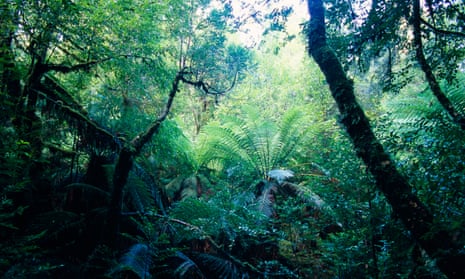Indigenous groups have criticised a Tasmanian government proposal to cover ancient midden sites with rubber mats to protect them from damage caused by reopening off-road vehicle tracks in the Tarkine, saying it is disrespectful and will cause further damage.
The Hodgman government referred the proposal to federal environment minister Josh Frydenberg on Friday as part of a three-year-long attempt to reopen the tracks, which were closed by the former Labor government in an attempt to protect an extensive network of archeological and cultural sites.
The proposal seeks approval under the Environmental Protection and Biosecurity Conservation (EPBC) Act for drainage, signage, fencing and 2.85km of surface protection to protect the heritage sites from vehicle damage.
But Heather Sculthorpe, a pakana woman and chief executive of the Tasmanian Aboriginal Centre, said the proposed protections would not preserve the cultural sites.
“Putting some rubber matting and plastic matting over middens and artefact scatters is not protection, it is destruction,” Sculthorpe told Guardian Australia.
Tasmania’s north-west coast is recognised as one of the richest archeological sites in Australia, on par with the Gunditjmara eel traps in western Victoria and the Burrup Peninsula in Western Australia.
It contains shell middens, stone hut depressions, seal-hunting hides and a number of petroglyphs or rock carvings that show evidence of semi-sedentary villages dating back to the late holocene period, or about 4,000 years ago.
An area of coastline dubbed the Western Tasmanian Aboriginal Cultural Landscape received national heritage protection in 2010 and has been described as “one of the richest and most significant Aboriginal cultural heritage landscapes present in Australia”.
In 2012, the Giddings government closed 37.2km of tracks, sections of track 501, 503 and 601, which were either wholly or partially contained within the nationally heritage-listed area in the Arthur-Pieman Conservation Area, on the coastline between Sandy Cape and the Pieman River.
There are 144 individual registered Aboriginal Heritage sites within 500m of the three tracks, according to the Tasmanian Aboriginal Heritage Information database.
An extensive network of tracks to the north of Sandy Cape remains open.
The Hodgman government reopened the three closed tracks as an election promise in 2014 but was stymied by the federal court, who granted the Tasmanian Aboriginal Centre an injunction blocking their use. In October 2016 the Hodgman government won the right on appeal to reopen the tracks on the recommendation that it seek federal approval under the Environment Protection and Biodiversity Conservation Act first.
Sculthorpe said the decision to go ahead with reopening the tracks made Tasmanian premier Will Hodgman’s recent comments about reconciliation ring hollow.
“That says to Aboriginal kids, Aboriginal adults, it reinforces the fact that Aboriginal people are at the bottom of the list of government priorities … they will never be closing the gap while that sort of disdain for us and our culture continues,” she said.
“They get up there and talk about reconciliation, they put a few words in front of the (Tasmanian) constitution to agree that we were the original owners, and then they go ahead and continue with this absurd plan to wreck our heritage.”
The proposal put forward by the Tasmanian government includes the proposed fencing and rubber matting, as well as: monitoring and evaluation of the cultural and environmental values of the area; a permit system restricting the number of 4WD vehicles to 12 a day between November and May; and hiring two rangers to ensure compliance with the permit system and ensure drivers are sticking to the pre-marked tracks.
It argues that illegal use of the tracks will decrease once they are formally opened and policed.
The proposal also says that endangered and vulnerable species in the area, which includes Tasmanian devils, spotted-tail quolls, hooded plovers, and for brief windows of the year the orange-bellied parrot on its annual migration, will not be significantly affected because the tracks will be readjusted to skirt around nesting sites and sites of cultural significance.
That presumes vehicles will remain on the designated tracks, an assumption Vica Bayley, Tasmanian campaign manager for the Wilderness Society, said was “delusional”.
“All the evidence goes to the fact that there are some people, obviously not all but some people and enough to do damage, that just don’t obey the rules,” Bayley said. “Further up the coast where four-wheel driving is still permitted fences have been cut to let people come through, petroglyphs have been chiseled.”
The supporting documentation provided by the Tasmanian government, including cultural heritage surveys and community consultation, is the information that was prepared and used by the former Labor government to justify closing the tracks.
In a letter to Frydenberg on Monday, Bob Brown Foundation campaigners Jenny Webber and Scott Jordon said the supporting documentation is not appropriate and “insufficient to allow for members of the public to be able to make informed submissions”.
Tasmanian government MP Joan Rylah, whose electorate of Braddon includes the Tarkine tracks, said in a statement on Tuesday that opening up the tracks would reduce the vandalism of Aboriginal heritage, and that the Aboriginal community “had made it clear they supported the move”.
“The recreational users have a clear vested interest to ensure that the Aboriginal heritage is protected, and they have committed to do this through education and the (Arthur-Pieman Conservation Area) management committees,” Rylah said. “We will not give up – we believe in the right of all Tasmanians to have recreational access to the Arthur-Pieman in a way that ensures the proper protection of its natural and cultural heritage values.”
The Tasmanian Aboriginal Centre, which is the peak body representing Aboriginal people in Tasmania, also said it would not give up until the tracks were permanently closed.
“We are not letting this go,” Sculthorpe said. “We will be making detailed submissions; if that doesn’t work we will be in the courts, and if that doesn’t work we will be on the ground.”
Submissions close on 22 September.

Comments (…)
Sign in or create your Guardian account to join the discussion